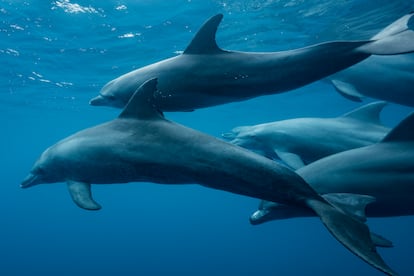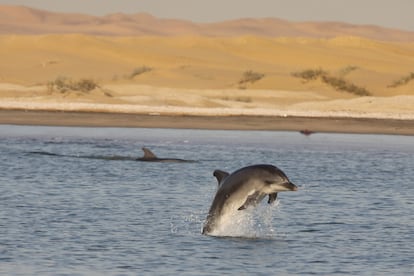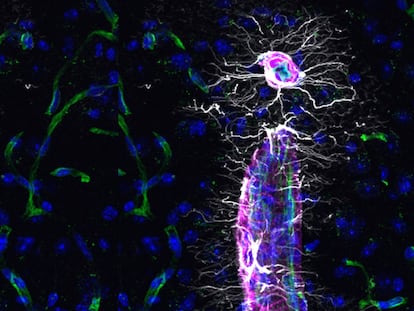Dolphins recognize their friends by tasting their urine
New research shows the mammal can identify other group members through their sense of taste, as well as their signature whistle

“Man had always assumed that he was more intelligent than dolphins because he had achieved so much – the wheel, New York, wars and so on – while all the dolphins had ever done was muck about in the water,” wrote Douglas Adams in his Hitchhiker’s Guide to the Galaxy. “Conversely, the dolphins had always believed that they were far more intelligent than man – for precisely the same reasons.”
Adams was trying to make the point that “things are not always what they seem” but the parallels are undeniable: it has even recently been discovered that female dolphins have clitorises which can give them just as much pleasure as female humans can get from theirs. And now it seems these marine mammals actually have one over on us as they have been found to recognize their friends and relatives by taste, a characteristic that has not yet been ascribed to humans; just as well, some might say, since dolphins do so by catching the flavor of their pee in the water.
A team of researchers has just published a study in the Science Advances journal on this ability in dolphins, a trait that has an important evolutionary component. “It’s important because dolphins are the first vertebrates shown to have the capacity for social recognition through taste alone” rather than the more typical sense of smell, explains animal intelligence specialist and the research’s lead author, Jason Bruck from Stephen F. Austin State University. “This is a new concept for our understanding of taste sensory biology and highlights how little we know about this sense in general.”
But there’s even more to the skill than first meets the eye: researchers found that eight dolphins were able to link the taste information from the urine to the characteristic signature whistle of each animal – dolphins have a unique whistle that defines them individually and functions like a name and other members of their group can recognize them by this whistle and even echo the sound back, in the same way, a person might use someone’s name. Basically dolphins use both systems to recognize each other and, more crucially, to think of each other when they are not present.
From an evolutionary perspective, it means that dolphins can “mentally track other individuals, even when they’re not around,” Bruck explains. “That’s adaptive because it allows dolphins to remember others with whom they have successfully partnered, as well as individuals with whom they have had bad experiences in the past, which is important for an animal known for surviving on its alliances.” In short, dolphins demonstrate an extraordinarily complex intelligence: that of making plans with other companions, even when they are not present.
Gossipy dolphins
What was already known was that dolphins can remember the name or acoustic signature of another dolphin that they have not seen, heard or tasted for as far back as 20 years. This means that dolphins “might also be able to make references to a third dolphin, referring to absent dolphins,” Bruck says. In other words, they may talk about another dolphin that is not present, like someone gossiping about someone or planning to meet a third party.
“Because dolphins can whistle about dolphins that are not immediately in the group at that moment, you have the same potential for contemplation about another as a human has when the name of a person is mentioned when they are not in the room,” explains Bruck, who is amazed by this acoustic social recognition system that is so similar to that of humans.

“It’s not every day that scientists find evidence for the use of name-like signals in a nonhuman vocal system. That’s pretty exciting,” adds Bruck. So, there’s the dolphin, rethinking the past, imagining the future, mentally tagging another animal with taste and sound, making plans, talking about others who are not present. And still mucking about in the sea, as Adams would say.
Researchers do not know exactly what mechanism allowed the dolphin to develop this ability, but they consider there’s a probable evolutionary cause as marine mammals are animals that, after developing a life on land, decided to migrate back to the sea, exchanging some abilities for others. “Dolphins have lost much of the brain structures around the sense of smell,” notes Bruck, and yet “some pathways remain in the tracts to the brain. These could have been co-opted by the sense of taste for this purpose.”
So, it is possible that they exchanged the cerebral faculty of recognizing others by a sense of smell for that of taste, which is more available to them, given their habitat. What is still unknown is whether dolphins urinate with a social purpose, in the same way, that dogs pee on trees and lampposts. Or whether their pee can be released on demand, as it were, as dolphins are known to examine each other’s genital area. It is possible, according to Bruck, that on examining one another, they trigger urination so they can taste the pee and store the other dolphin’s identity in their memory.
Tu suscripción se está usando en otro dispositivo
¿Quieres añadir otro usuario a tu suscripción?
Si continúas leyendo en este dispositivo, no se podrá leer en el otro.
FlechaTu suscripción se está usando en otro dispositivo y solo puedes acceder a EL PAÍS desde un dispositivo a la vez.
Si quieres compartir tu cuenta, cambia tu suscripción a la modalidad Premium, así podrás añadir otro usuario. Cada uno accederá con su propia cuenta de email, lo que os permitirá personalizar vuestra experiencia en EL PAÍS.
¿Tienes una suscripción de empresa? Accede aquí para contratar más cuentas.
En el caso de no saber quién está usando tu cuenta, te recomendamos cambiar tu contraseña aquí.
Si decides continuar compartiendo tu cuenta, este mensaje se mostrará en tu dispositivo y en el de la otra persona que está usando tu cuenta de forma indefinida, afectando a tu experiencia de lectura. Puedes consultar aquí los términos y condiciones de la suscripción digital.










































